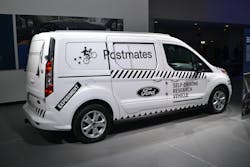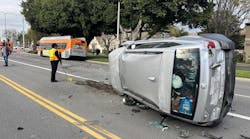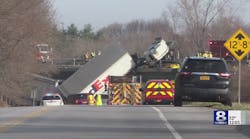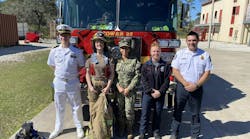Topic: Autonomous vehicles
Objective: Increase awareness of design, features and operation of current or proposed models of autonomous (self-driving) vehicles
Task: The rescue team shall review and discuss responder safety and fire/rescue concerns regarding current or proposed autonomous vehicles.
This University of Extrication column is our first look at self-driving vehicles, also known as autonomous vehicles (AVs). Our discussion is primarily from a responder’s point of view with attention paid to vehicle safety features and how they will operate when the vehicle encounters unplanned events.
National Highway Traffic Safety Administration (NHTSA) statistics show that 94 percent of serious crashes are due to human error.1 AVs, programmed to control operations of the vehicle without driver intervention, have the potential to eliminate several human-error factors that we encounter out on the highway, such as the drunk, drowsy or distracted driver. In theory, this technology could actually improve responder safety by reducing occupant crash-related injuries and even our overall frequency of traffic crash calls. But even with these reductions, accidents will always happen and first responders need to be prepared.
Already on the road
Recently, General Motors made an announcement that by 2019 they would be producing a test fleet of AVs that have no steering wheel and no pedals.2 Ford Motor Company also reports that a ride-share service with a Level 4 driverless vehicle could begin in 2021 (See sidebar for the 6 levels of AVs.)
One area where AVs are being considered is in the field of delivery of packages, products or materials. Ford Motor Company is already pilot testing a self-driving pizza delivery vehicle in Ann Arbor, MI. The Domino’s Pizza Ford Fusion hybrid test vehicle is covered with enough unique research vehicle markings, cameras and roof-mounted equipment that responders should be able to readily identify that it is a special vehicle and that no human driver may actually be present. Remember, there are no current requirements for AVs to be readily identifiable to responders when arriving at a crash or fire incident.
Safety concerns
A self-driving vehicle with no passengers present also means that there would be no one at the crash scene with knowledge of how to shut the AV vehicle down and no one to explain to responders what safety concerns need to be dealt with post-crash or post-fire.
Another responder concern, and one that researchers are aware of, is that today’s generation of self-driving vehicles, when traveling at highway speeds such as over 50 mph, are seriously limited in their ability to react to stationary emergency vehicles in the lane of traffic, obey “Move Over” laws, or even “see” traffic cones, highway flares, or personnel serving as flaggers at a vehicle crash scene or other unplanned highway event. This is a huge concern for responders and something that manufacturers, researchers and government agencies must actively work toward addressing. Testing being done by Ford, Argo-AI and other companies place a “Safety Driver” in the AV to handle such unplanned situations that might be encountered during real-world road testing.
The NHTSA advises that autonomous vehicles need to have the ability to identify/detect approaching or stationary emergency vehicles. NHTSA also notes that AVs must detect and react when they encounter temporary work zones such as what we create at a traffic crash scene. They must also be capable of “seeing” individual responders standing in the highway while manually directing traffic, or any other out-of-the-ordinary conditions that typically appear at our traffic incident management scenes.
Once an object in the road or an unplanned event is encountered, the AV must be able to process that information (recognize) and know how to respond (react) appropriately. Currently, AVs have experience in low-speed, city surface street environments, but still need to be “trained” to recognize, identify and react appropriately without a human driver being present when on a higher speed roadway or highway environment outside of a city setting.
References
1 NHTSA. Automated Vehicles for Safety. www.nhtsa.gov/technology-innovation/automated-vehicles-safety.
2 Boudette, Neal E. G.M. Says its Driverless Car Could be in Fleets Next Year. Jan. 12, 2018. www.nytimes.com/2018/01/12/business/gm-driverless-car.html?em_pos=small&emc=edit_ws_20180116&nl=wheels&nl_art=5&nlid=33585877&ref=img&te=1
SIDEBAR:
The 6 Levels of Autonomous Vehicles
Level 0: No automation
Level 1: Driver assisted operation
Level 2: Partial automation
Level 3: Conditional automation with driver intervention
Level 4: High automation of all aspects of driving
Level 5: Full automation of all aspects of driving task
Source: Society of Automotive Engineers (SAE), J3016 standard
Note from Ron Moore: The recent report of an autonomous vehicle involved in a pedestrian fatality incident in Tempe, AZ, has raised public awareness of these vehicles and must remind responders that like it or not, our future will involve self-driving vehicles in some fashion. Lessons learned from self-driving vehicle collisions that have already occurred clearly show us that there are new risks and unique new challenges that lie in store for us now and in the weeks, months, and years to come.







